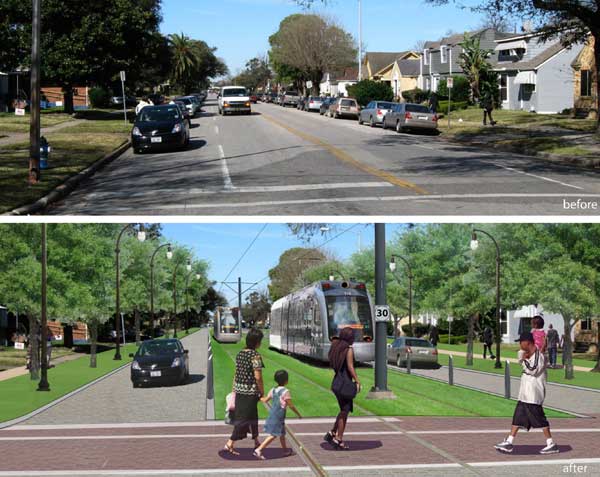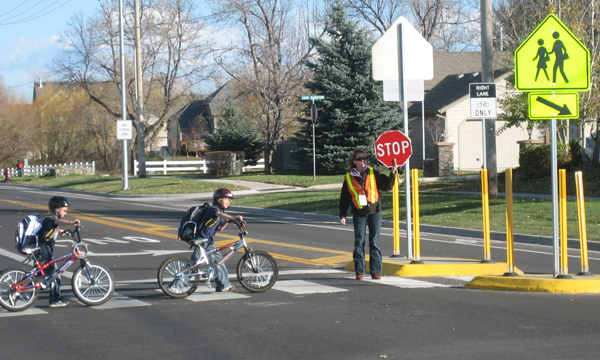News
Interview with Paul Morris, FASLA
 Paul Morris, FASLA
Paul Morris, FASLA
It's an evolving program at this point. It's mostly through the Environmental Health Division, and they're looking at ways to contribute to the efforts around the country focused on creating healthier living environments. In particular, they're focused on the design of communities. The CDC assembled a group of 15 or 20 people recently in Atlanta for the purposes of evaluating the approach and methodology that they might use in creating, potentially, a new center around healthy community design. I was asked to participate as a representative from the ASLA. They had representatives from a variety of other professional associations, non-profits, governmental entities involved.
Health equity relates to the "right to public health." According to the CDC, "Most health disparities affect groups marginalized because of socioeconomic status, race, ethnicity, sexual orientation, gender, disability, geographic location, or some combination of these." Disadvantaged communities are often disadvantaged in terms of access to transportation options. Unhealthy communities lack sustainable transportation infrastructure, such as sidewalks, bike lanes, or low cost public transportation. These communities also often lack green infrastructure -- parks, green roofs, trees. What kind of infrastructure investment is needed to remove these inequities?
You've identified a number of the elements that would be necessary for more healthy community to be available to these populations. Land use and transportation decisions often are the biggest issues. Not only is ease of access important, but also the availability of services and things like nutritious foods as well as access to education. The lack of mobility in terms of accessibility to non-auto transportation adds to that. The CDC is looking for ways to try to improve that as well.
For them, the big issue is a lot of regions or communities do not understand the kind of direct corollary between health and the interface between land use and transportation decisions. They're not only looking for ways to improve on the availability of better transportation and a more mixed use land use environment, but they're looking for ways to influence organizational development at the local government level. They're looking for ways to contribute to the financial or fiscal mechanisms that are necessary to provide these services and facilities. They're also looking to influence the political process, in that they're trying to create factual reference points that can contribute to the conversation -- whether it's through health impact analysis (which is a tool they've used through their community health organizations) or things like the LEED green building certification process, the Sustainable Sites Initiative, or the ICLEI STAR Community Index process.
All of these things are intended to provide quantifiable reference points for communities around the country so they are able to evaluate their public policies and fiscal decision making and achieve better community design and more effective environments that create options for folks to gain access to healthier food and living conditions.
What needs to come first, healthy community infrastructure (sidewalks, bike lanes, promenades), or demand from local communities for this infrastructure? What's the best way to create demand in places where this infrastructure has never existed?
There's a lot of debate around that. In examples around the country, what has been found is that where communities take the initiative to actually install the infrastructure, there is, in fact, a significant pent-up demand that has been unmet. It's kind of a "if you build it, they will use it" situation. In different cities around the country, where they've done things like added bike lanes on streets, or built sidewalks where they didn't exist, they were surprised at the increase in usership by walkers and bicyclists for those kinds of facilities.
It really requires some leadership on the part of local governments to devote some percentage of their infrastructure resources to making these things available and attract people to use them. You know, it isn't enough to just say, "Well, people say they want them, so we're going to build them." You actually have to have them there for people to know that they're available for use.
 ASLA 2009 Analysis and Planning Honor Award. Urban Corridor Planning — City of Houston, Houston, Texas. The Planning Partnership Limited, Toronto, Ontario, Canada
ASLA 2009 Analysis and Planning Honor Award. Urban Corridor Planning — City of Houston, Houston, Texas. The Planning Partnership Limited, Toronto, Ontario, Canada
U.S. First Lady Michelle Obama has made childhood obesity her top priority, saying recently, "Nearly a third of all children in this country are overweight or obese, and a third will suffer from diabetes at some point in their lifetimes." Obama pointed to poor nutrition, parents' long work hours, and dirty or unsafe neighborhoods as key problems. Obama said, "There's also often a lack of safe and accessible facilities for play." How can creating healthy community infrastructure help alleviate children's health problems? I agree not only with those identified contributors, but I would add what was talked about a lot at the Healthy Communities Design Forum -- the increased level of sedentary activity on the part of a lot of families, and kids, in particular. Kids spend a lot of their free time in situations where they aren't actively engaged, whether it's passive recreational pursuits or active sports and recreational activities. In addition, where kids have, in many cases, dual-parent working households, it makes it very difficult for the parents to actually support those efforts.
While the problems that are causing all of this are relatively self-evident, the challenges have to do with not only making the solutions available, but making them readily accessible. The solutions need to be close to home or schools, and safe and secure for kids to use throughout the day, the week, and throughout the weekend. It's important to make access to those facilities safe and convenient, so there are actually bicycle ways and sidewalks that kids can easily walk to. In a lot of cities, you've got developments without really any convenient or ready access to those kinds of activities, so there's a pretty significant gap between demand and supply.
 Safe Route to School / Alta Planning + Design
Safe Route to School / Alta Planning + Design
Insufficient physical activity has been linked to a range of diseases in both children and adults. What are some of the most effective ways to support and encourage exercise through landscape architecture?
Active elements have to do with the introduction of widespread indoor and outdoor recreational facilities. The second area in which they can help is through the development of recreational programs -- the design of systems -- that are adaptable to the recreational needs of a community.
The passive part is really just better and more frequent design of facilities that makes it possible for people to access transportation, those recreation activities. Whether it's backways, sidewalks, or other trails, you've got to have ways in which people can get access to the parks, recreational facilities and programs that are being designed.
What is the CDC, and the federal government more broadly, planning to do on healthy communities in the future? In particular, is the CDC working with the Department of Transportation initiatives like Complete Streets, Safe Routes to Schools, and others, that will foster more healthy communities?
Under the new administration, the CDC is not only doing those things that you've just described, but they are becoming an active participant in the President's Livable Communities Partnership that was developed in concert with the Congress. The partnership is essentially requesting that the Department of Transportation, EPA and HUD create an alliance focused on how they can regulate facilities, services, and functions within a community for livability. The partnership can enable funding in a more efficient and mutually compatible way, and CDC, as well as other agencies, has been invited to participate. Obviously, CDC will participate through the Department of Health and Human Services.
Most recently, the CDC is finding that public health and community health really are important indicators to determine whether a lot of the decisions made around federal funding for and regulation over services and functions and facilities are effective. Community health can be promoted through transportation; through EPA (through their clean water, air and land activities); or through HUD, by expanding its role beyond just housing and actually talking about urban development. Complete Streets is part of their program.
This process is going to result in a variety of initiatives to modify the way in which each of the federal governments go about decision-making on their investments, the rules that they apply, and the kind of procedures that are required of local governments to comply with them, and even the criteria that are used to evaluate the merits of various programs that are being submitted for application and financial or regulatory support. They hope communities will embrace and endorse objectives from all of the various organizations, and, at the same time, the agencies are systematically finding ways to eliminate or reduce the number of conflicts or inconsistencies, or inherent contradictions between various agencies' programs.
Lastly, how can landscape architects, architects and planners foster change in their own local communities? Are there particular assessment tools you recommend?
There's been a fair amount of conversation on this point. The one tool the CDC has at its disposal is the Community Impact Analysis, or Community Health Impact Assessment tool, and it's useful and getting a modest amount of application. Other areas where ASLA and design and engineering professions can help are in broadening the use of USGBC's LEED and LEED-Neighborhood Development (ND). There's also the addition of the Sustainable Sites Initiative, which CDC is looking at as a tool for broader landscape initiatives. Then, designers, whether it's landscape architects, planners or others, need to be actively involved in the acceleration and expansion of the ICLEI effort to create what's called the STAR Community Index, which is essentially a method to provide tangible, analytical, and quantifiable reference points for a whole suite of community design questions, whether they have do with the: physical design of public places, community design of the private environment, residential areas, mixed-use developments, employment centers, retail, commercial and institutional, as well as industrial complexes.
Beyond that, CDC is also looking at how the design and planning professions are contributing to the creation of model practices that can be provided as tool boxes or menus for various communities, a program called the "Initiative to Create Scalability of Best Practices." There are a lot of good anecdotal projects around the country that have demonstrated healthy communities design successfully, but they've not achieved the kind of momentum that has resulted in widespread or broad- based application. The CDC is hopeful that through their efforts they can work with all the different for-profit and non-profit organizations to create not only a menu of different analytical tools to evaluate what healthy communities look like, but actually serve as a vehicle to help provide technical assistance, financial grants and other support, as well as models based on research of best practices that can be transferred and applied across the country, whether it be in urban, rural, or even the smallest communities around the country.
Paul Morris, FASLA, is a former president of ASLA.
Interview conducted by Jared Green.